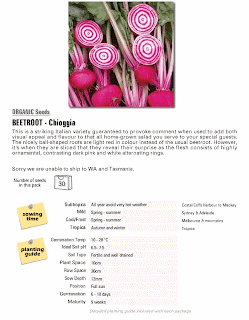I am so excited! As I hve just bought another batch of seeds for my veggie patch, as well as a few for the garden and in preparation for the herb garden Matt is planning beside the shed.
I've bought them on Ebay from 2 of my favourite sellers; celebrationvillage (Aneesha) and heritageseeds. These guys supply heirloom seeds, and some rare type within Australia (and not to WA or TAS), so sorry if I just got your hopes up.
And thier really good value and celebrationvillage send really helpful little planting notes (heritageseeds details are on the listings) and both have unusual and rare varieties of plants. Which always makes for exciting meals :)
 Where possible I would recommend buying seeds, cutting, seedlings etc locally, as the plants have been successful in that area and are suited to the conditions.
Where possible I would recommend buying seeds, cutting, seedlings etc locally, as the plants have been successful in that area and are suited to the conditions.
But I have used both of these suppliers in the past with success and am hoping the hierloom varieties willprove fruitful in seed terms too. Then 20 seeds turns into a lifetime supply of fruit/veg/herbs.
This time I bought;
Thai Basil, Dark Basil (opal), Sage, Cumin, Chives, Garlic Chives, Dill, Parsley, Oregano, Bok Choi, Red Pak Choi, Wombok, Rainbow silverbeet, Artichoke, Golden zucchini, Chioggia Beetroot (a stripey variety), Brussel Sprouts, Burdundy Okra, Italian Radicchio mix (12 varieties), Chicory, Celeriac, Kokl Rabi (Purple), Cress, Armaranth (red), Rhubarb & Alyssum (royal carpet)- flowers for ground coverage and hopefully fill in the spaces in the garden path... now I just have to be patient until they arrive!

